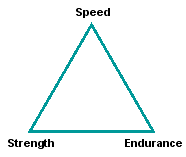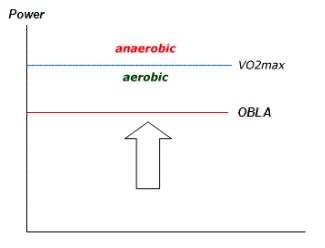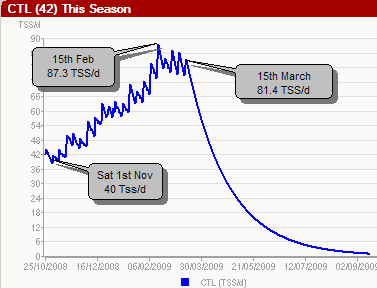How Do I ~ Get Fit To Race?

Fitness is an ethereal marker that we are all trying to attach to ourselves.
For some fitness is the journey for others it's the destination.
I think I'm fit, but next to Jens Voigt (I've compared us before!) any fitness delusion of grandeur is quickly dispelled.
Having said that for what I do, at the level I do it and the frequency of doing it, I'm as fit as I want to be and as fit as the time I have available allows me to be.
Could be fitter, as I'm sure could you, but it's being "professionally dissatisfied with current fitness" that makes us competitive cyclists. So on the premise that we first need to define fitness, let's continue.
Fit for what?
Let's start at the beginning. What are you getting fit
for? Or if you're posh; For what are you getting fit?
A one off championship event, a 10 mile TT Series, local road racing, national road racing, a multi-discipline stage race, the Etape, a series of sportives, a 24 hour event or just to enable the enjoyment of riding your bike and to live a little longer? Each and every one of us has a different reason for wanting to have a level of defined fitness.
Each of the above valid fitness reasons have a markedly differing physiological requirement. The fitness needs for a 20 minute, 10 mile TT are very different to those needed for the Etape. So let's break the fitness equation down in to clearly defined measurables.
First, we need to define the fitness markers that will help us meet our goals. As everyone reading this article is an, if not actual at least potential, athlete let's go with performance fitness rather than just normal people's wellbeing fitness.
For any competitive cycling event or endurance challenge, as a starter, we have requirements for knowledge of our current levels of:
|
 |
Once we know where we are (possibly through some sort of fitness evaluation, test or how far we're behind everyone else on the big hill) we can then do something about improving it.
Knowing where we are gives us a starting point; defining a goal or an objective will help us focus on where the end point needs to be. All we then have to do is define, build and implement a plan for bridging the gap between the two.
Endure
In years gone by, before the century started with a two, there was a general clubman's consensus
that you had to have massive LSD, Long Steady Distance, in your legs
before undertaking any strength work on the bike.
This aerobic development work was carried out at a relatively low speed in a medium gear. These were your classic club runs running from a couple of hours up to four, five or six, or as long as daylight would allow.
This was done with one bottle (with just water) to get you to harden up! During the week you did the same and went out on three or four nights, riding until your wonder lights ran out.
To some extent things haven't changed, it's just got more comfortable. You still need to build a solid endurance base and get yourself fit for purpose. But now you can use isotonic drinks, gels, power foods and Gore Tex. And if something happens you can call someone on a mobile to come and get you.
Just because you can do more, doesn't mean more is better. Your endurance has to be specific to the task in hand. So if you plan on riding a 180k sportive, doing two hours on a Sunday morning isn't enough. For a 10 mile TT it's perfect.

Endurance is still the cornerstone of aerobic training so make sure at least one of your weekend rides is building to a duration that reflects the events for which you're getting fit.
For "big" endurance events and sportives, I reckon on being comfortable riding two-thirds the average target time. So for a nine hour event, six hours should be your max ride target; for a six hour target it's four hours endurance. And you only need to hit it a couple of times before your event, not every week of the winter!

Early weekend training should concentrate on endurance
Month One and Two of your programme
Mix & Match
Again in the old days it was deemed that there was a
demarcation between strength and endurance work. You did your
endurance; when you'd got that in the bag you moved on to strength and
when the season started you used early season races to get your speed.
This approach still works and has merit for those that have the time to spend. It's not wrong, it's just not very time-efficient.
In today's world of quick fix, instant gratification and advanced training knowledge and techniques, we can now "enjoy" hard work the whole year round.
Use the weekends to build aerobic endurance and use the mid-week days to carry out ever increasing intensities of anaerobic strength and conditioning.
As you get within eight weeks of your season start, the weekends should not be exclusively aerobic work.
Long, slow, distance can now be replaced with distance mixed up with intermittent bouts of anaerobic work and climbing. Which for us translates in to the infamous flamme rouge Classics Circuits.

The wider the base the higher the peak
Month Two and Three of your programme
Icing on the Cake
Getting fast hurts so you need to be psychologically primed
as well as being physically prepared. Once you've banked your
endurance and strength you can start honing your speed.
You would have started this some three months previous by doing endurance intervals of up to 20 minutes duration. Over the months these interval durations drop, as we manipulate the constituent parts of The Triumvirate of Pain (see lower down the page).
As we get in to the season start, or near your key event, you could end up doing incessant 10 second bursts of lead out pace. Once you've done a couple of weeks of these little speed builders you will have your definition of pain clearly redefined. You'll also have more speed than you ever thought possible.

Building the Peak
Month Three and Four of your programme
Bringing it all Together
A few weeks before "where
you need to be", you should be "where you need to be".
Define your goal, set out your key objectives, clearly identify the specific fitness requirements you need for success, (to ride for eight hours, to average 25 mph, to sprint at 950 watts for 20 seconds, to get to the end, etc,) then decide when you need to be there.
Once you have your target date you drop back a week or so, as this will be your taper period, then aim to be at your peak fitness before you taper.
Work out how many weeks you have between now and your target, then fill the gaps with a set of training drills that will get you to two weeks before your target, fit for purpose.
Remembering to build in a recovery and adaptation week every month. A lot of people forget that recovery is a key constituent of training and continued, sustainable, performance improvement.

Target Date: Your fitness will now have
developed from the inner pyramid to the outer.
Obviously this factsheet is generic and only delivers the basics of getting yourself fit. You'll need to read a few of the other pages of this website to get the other missing pieces of the jigsaw.
The
Triumvirate of Pain
Every training session is
made up of three ingredients that are defined by the acronym FIT.
Every single session ever devised, is defined by a combination of
Frequency, Intensity and Time.
I know you're probably sick of triangles by now but there's no escaping them; here's another one!
▼ Frequency |
 |
The classic FTP development interval is; do two, XYZ watt intervals for twenty minutes with a five minute rest. Where XYZ is the defined intensity drawn from a percentage of your 60 minute power output.
Frequency is the number of times you carry out the effort within the interval or number of times you carry out the training session.
Intensity can be set by speed, power, heart rate or perceived exertion. It is what it is; an indicator of the level of pain.
Time is obviously the duration of the pain being suffered. Be it an interval within a session or the session itself.
Manipulating the Pain
You can't just keep doing the same thing and expect to get
fitter, faster and stronger. You may get one or the other, but not
all three. To get all three you have to manipulate your training.
To do this you have to adjust one of the three ingredients.
The three points of the triangle are mutually exclusive parameters. If you increase one then one, or both, of the other points of the triangle will need to decrease. Here's an example...
You can probably do five (frequency), four minute (time) intervals at 300 watts, 40 kph, or 185 bpm (intensity).
But you couldn't do ten; or five for ten minutes, or five for four minutes at 500 watts.
When one goes up, one of the others has to go down and the third stays the same.
The sad ones amongst you will realise I've done nothing clever here, just adapted the classic Project Management Time/Quality/Cost Triangle.
When we start our early winter training sessions I often begin with a 10 minute Tempo Session to get people back in to the groove. We ride for 10 minutes at say 230 watts, then take a five minute recovery, then go again for ten, recover for five then again for ten. Here's a graphic.

To encourage progression each week we manipulate the recovery time. So in week one it's five minutes, in week two it's four minutes and in week three it's three minutes. At the end of three weeks you're doing the same amount of work over a shorter time period so by definition you're already getting fitter.
You could keep the recovery at five minutes and increase the wattage each week by 10 watts. But that brings about different physiological adaptations and it starts getting complicated to explain! It all depends on what you are trying to achieve.
But you can see how you set a marker and manipulate parameters to increase your level of fitness. Once the fitness plateaus you revaluate your marker and head off in a different direction. As I said earlier, don't keep doing the same thing and expect different results!
A Very
Basic Fitness Plan
Here's an outline for getting yourself fit to compete...
▼ Decide how fast or for how long you want to go
▼ Build in a steady weekend endurance base
▼ During the week build FTP and VO2max
▼ After six weeks introduce strength climbing
▼ After nine weeks introduce speed climbing
▼ When strong over chosen distance introduce speed
Raising the Bar
Below is a graphic that you'll find in a few
places on this website.

The blue line is your genetic potential
gifted to you by your parents;
it's this potential that you are looking
to realise. The red line is where you now are.
Your objective, as a competitive cyclist, is to move the red line as close to the blue one as you can. There are two ways of doing this; nudging it up from underneath, or dragging it up from the top.
You nudge it up from underneath by riding FTP Development Intervals or you drag it up from the top by riding wVO2max intervals. You mix it up with weekend steady state endurance rides interspersed with speed and strength work.
Sounds very complicated and almost impossible to square the circle of dichotomous needs. Which is a posh way of saying, how can you build speed and endurance, or aerobic and anaerobic needs, at the same time.
Well realistically you can't but they do in a weird way influence each other. Increasing one will automatically have some intransigent effect on the other. This is why you need a plan, drawn up by yourself, or someone who's done all the thinking beforehand to make sure that the balance is maintained and progression is assured.
The Message
So, how do you get fit enough to race? Easy answer, by a watt at a time.
Do the right things in the right order and you'll get yourself fit enough to compete at whatever SMART level objective you set yourself.
Do the right things in the wrong order, or the wrong things in any order, and at best you'll become fatigued and at worst you could become overtrained. Whatever the outcome you'll not be making best use of your time, energy or ability.
Build base, build endurance, layer on strength; add speed and you have the equation for power. You'll then be in the ball park to enable yourself to influence events within your chosen competitions. Become a player, don't become the played.

Here's one of my winter fitness marker graphs from WKO+. You'll see how fitness builds from November 1st (training day one) to its February peak (the end of the endurance phase).
It then drops as time and distance are sacrificed in March when we begin the early competition phase, to build outright (it's a relative term!) speed. As in the triangles above, intensity goes up, duration comes down.
It's here for nothing more than to graphically explain how you slowly build your endurance fitness to a peak, then back off and build speed. It's also there to show there are no quick fixes. It takes time, it takes effort and it takes a bit of thought. Haphazard training brings haphazard results.
Don't rush it, enjoy the journey, live the day and make some life-long memories in the event of your choice. Otherwise, what are we here for? Or if your posh; for what are we here!?
Good luck...
To see what happens when you do the right things in the wrong order look here.. It's eight minutes but it'll cheer you up no end.








